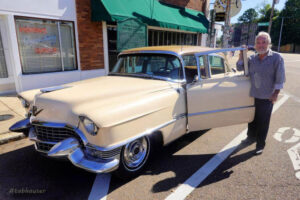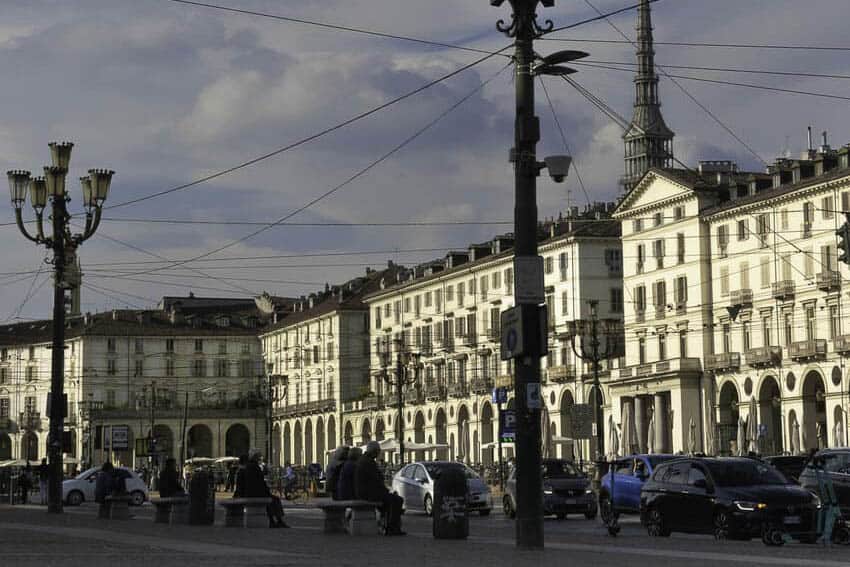
By Jennifer Kim
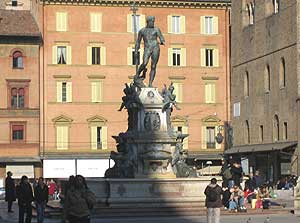
Venice, Rome, Milan and Florence are the ‘name-brand’ cities of Italy. However, the heart and soul of Italy is located in the underrated northern region of Emilia Romagna.
The Three P’s of Parma
Parmigiano Reggiano cheese, Prosciutto ham, and prestige are the three P’s that represent Parma. The aristocratic town of Parma is located in the upper Midwest region of Emilia Romagna.
Marie Louise Habsburg transformed the small town of Parma into one of esteem and elegance, the town we see today. The appointed Duchess of Parma by the Congress of Vienna, Marie Louise Habsburg’s signature sophisticate-style is embellished throughout the town.
Buildings of the elite and influential are painted with a Parmigiano-like yellowish hue, named “yellow Parma” after the city’s pride and joy. Coincidence? I think not.
Parmigiano Reggiano is highly valued and makes its appearance in almost every dish possible. However, Prosciutto should not be overlooked. Both of these local specialties are so cherished in the area that they are given their own museums solely dedicated to the history and process of these foods.
The Duchess of Parma won over her subjects’ and citizens’ favor by opening the park and the Palazzo Ducale (Ducal Palace) and the Palazzo della Pilotta to the public. The park is still adored by the citizens of Parma as they stroll along the grounds and listen for hints of melodic music lingering out of the Teatro Regio.
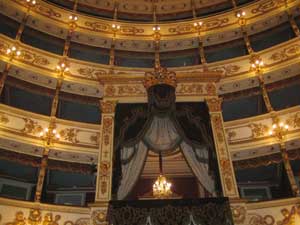
The Duchess had endowed the town with the love and appreciation for fine music. Such renowned performers, composers and conductors as Luciano Pavarotti, Niccolo Paganini, Arturo Toscanini and Giuseppe Verdi (born and raised in Parma) have been featured at the breathtaking Royal Theater.
Tomatoes Banned
The audience of the Royal Theater used to be infamous for being the toughest music critics — it goes hand in hand with being passionate music lovers. Tomatoes were often seen flying midair in the direction of the stage.
Rating performances by chucking of tomatoes were banned in the ‘60s. However, the dedicated theatergoers never miss a spectacular show as tickets are hard to find and almost every seat is sold out. That’s approximately 950 seats sold per show! It doesn’t hurt to be an aristocrat here!
Parma also boasts dozens of exquisite cathedrals and basilicas in the downtown area. The Piazza Duomo is not to be missed. Built in the medieval period, the building is a classic example of the Romanesque style.
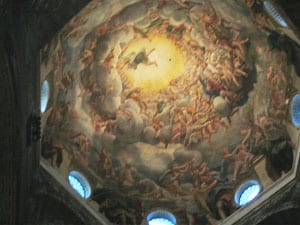
And don’t forget to look up! The dome of the cathedral portrays angels and archangels swirling high around the clouds and into what appears to be the heavens above.
Once criticized for looking like a soup of frog legs, Correggio’s work is now considered divine art by visitors and members of its congregation.
Just next door is the Battistero or the Baptistery. Not the usual architectural style for cathedrals, this Gothic-style baptistery is indeed unique, shooting up like a tower.
A little challenge for you: try and find the Pagan zodiac symbols arranged in the interior of the building.
The “Motor Valley”
What do Ferrari, Maserati, and Lamborghini have in common other than that they are the most lustfully sought-after automobiles in the world? These legends were born and bred right in Modena or the “Motor Valley” as the town is now dubbed.
These beauties stroll down the streets of Modena in the Spring, where the citizens of the town can gawk in the splendor of the new models.
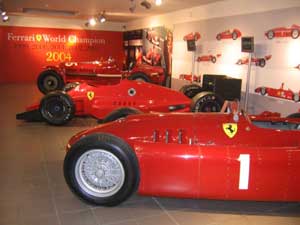
Modena is still recognized as the town with the “black gold,” Aceto Balsamico Tradizionale di Modena. Aged to perfection, this balsamic vinegar is as highly prized as fine wine. Don’t forget to grab a bottle or taste a sample of one of the older vinegars. The comparison of the old and young is very interesting. The older the vinegar, the sweeter the taste, which also means heavier on the wallet!
Besides the “black gold”, the town also treasures some “red rubies.” The Galleria Ferrari is solely dedicated to the man himself — Enzo Ferrari’s life and the legend he created. Giovanni Perfecti, the director of the museum greets thousands of visitors every day.
The gallery itself holds 40 models, but they vary each day. Formula 1 Racing cars and GTs, from the very first one produced in 1947 to the most recent, are showcased in clean and spotless rows, with only the cars, motors and trophies glistening in the spotlight.
The red bodies of the cars sparkle from room to room capturing the passion Modena has for its Ferraris. The town celebrates its racing victories with pride. The priest rings the cathedral bells every time a Ferrari wins the Grand Prix. The last time the bells tolled were in 2004 with Schumacher’s victories.
Panini Museum

A little way from downtown Modena, you will find the Panini family’s private car collection — a special treat for Maserati car lovers. Hombre it is called. Don’t be misled by the fields of cows.
The Hombre farm is also one of the lead manufacturers in, what else, Parmigiano Reggiano. Classical music is heard throughout the farm. Roberto, one of the brothers of the Panini family explains, “It soothes and relaxes the cows. It helps with the quality of the cheese.”
Whether it’s the classical music or the serene view of the car collection, these cows are producing fine quality organic cheese — approximately 4,000 wheels of Parmigiano Reggiano a year!
The aroma from the aging cheeses drifts towards the Panini Museum across the dirt road. Umberto Panini saved the Maserati legacy by purchasing the entire collection to prevent the cars from being auctioned off individually. The cars are now safely housed in the Panini family’s care.
The adrenaline rush continues to pump through the veins as we head over to the Ducati Museum. Ducati is acclaimed for its single cylinder and 90? V-twin cylinder engines. The numbers don’t lie. About 30,000-35,000 Ducatis are produced yearly and distributed worldwide.
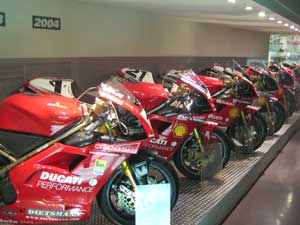
The Museo Ducati holds over 40 motorcycles in its headquarters. With seven exhibition rooms, you can go through the timeline from the Original Ducati Cucciolo dated back in 1946 after WWII to the last room updated in 2004. The most recent victory for Ducati was on June 15, 2003 in Catalunya.
No Baloney about Bologna
Holding the world’s largest university, Alma Mater Studiorum, you can be assured Bologna can teach visitors and tourists a thing or two about culture. The starting point begins at the heart of the city’s center, the Piazza Maggiore.
Scanning the piazza, you’ll come across the classic fountain of Neptune, Fontana del Nettuno. On closer inspection, you will notice the mermaids surrounding the Neptune God and with even further inspection, you’ll see water spouting out of the mermaids’ particular body part.
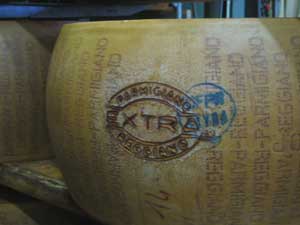
The piazza itself is surrounded by historical buildings — the Basilica del San Petronio, one of Italy’s largest cathedrals, the Palazzo Re Enzo, where King Enzo was imprisoned in the last years of his life, and Palazzo del Comune, where sculptured art embellishes the edifice of Madonna di Piazza, an eagle dedicated to Michelangelo and Pope Gregory XIII.
Not far away, two towers break the skyline of Bologna. The two towers, Asinelli Tower 318 feet (97 meters) high and Garisenda Tower 157 feet (48 meters) high are right off the main street of via Rizzoli. You may want to rethink climbing the taller of the two towers. It has 498 stairs!
As you stroll along the cobblestone streets past all the specialty shops selling baloney (it is Bologna after all!), parmesan cheese, and other foods and crafts, don’t forget to look up. The portico running through the city is the longest in the world, covering approximately 30 miles.
Down the main street of via dell’ Indipendenza, try not to lose yourself amongst the back-to-back trendy boutiques and shops leading to the funky street markets. For an obscure taste of the many cultures prevalent in the city, grab a drink at the Transylvania Bar for a “soul-searching” experience.
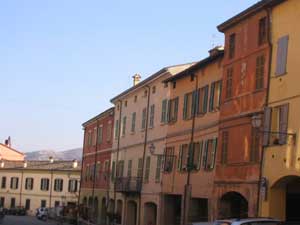
The Blood of the Gods
At the foot of the Apennine Mountains, the ‘Blood of the Gods” flows through the valley keeping it alive. The Blood of the Gods refers to the staple of Italian cuisine — extra virgin olive oil.
In the cooler Northern part of Italy, there are only two places where olive trees are harvested. In between the Lamone and Senio Rivers, Brisighella is the perfect source for this treasure. The valley’s climate is mild, just right for producing the perfest olives for the perfect olive oil.
This small, enchanting town takes you back to the Medieval times. Jutting from the ancient town stand the three pinnacles, each adding to the medieval feel: the fortress Rocca Manfrediana, the Clock Tower, and the Monticino Sanctuary. The whimsical world of the Middle Ages is recreated in June and July at the town’s biggest festivals.

Emilia Romagna
The winding roads are speckled with rows of houses brushed in colors of clay, mustard yellow, salmon and cream, all reflecting the natural surroundings. Along the road, you’ll need to stop at the quaint shop of La Fonte del Piacere. Giuliano, the owner, and his family will gladly show you the distinctions between the aged olive oils and give you a taste of selected local wines.
Another road in a class by itself is the Delgi Asini, otherwise known as Donkey’s Street. The road was elevated and covered with porticoes and was used for transporting materials to the mountains by donkey. Later, cave-like houses were built into these roads that are still used today!
Brisighella is also known for their natural spring waters and spa centers. So go on! Take a breather from all that wine and olive oil.
Jennifer Kim lives and writers from Philadelphia, PA.
- These 9 U.S. National Parks Require Reservations in 2024 - April 17, 2024
- Take a Hike in Olympic National Park - April 17, 2024
- The Wild Mississippi: 2340 Miles Across Ten States - April 8, 2024



